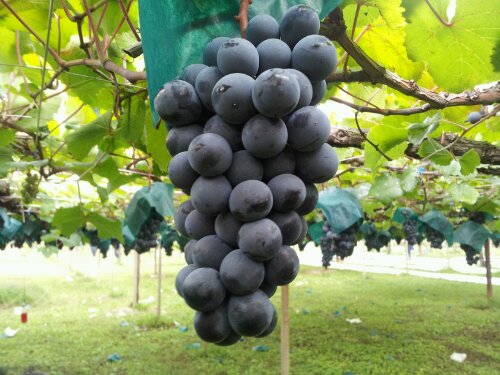The History of Japanese Wine
Japanese wine is believed to have been introduced in the late Muromachi period. In 1469, a noble's diary titled "Gohouin Record" mentions a beverage called "Chinta," thought to be red wine introduced from Spain or Portugal. This is considered the earliest record of wine in Japan, and as trade with the Netherlands and Portugal grew, wine gradually spread across Japan. However, rice-based alcohol was more common in Japan, and with ample access to clean drinking water, a culture of fermenting fruit for alcohol did not take root.
In the Edo period, grape cultivation began in Yamanashi Prefecture (Koshu region). However, the grapes grown were mainly for eating fresh or for processing, not for wine production. It wasn't until the Meiji period that winemaking truly began. As part of its industrialization policy, the Meiji government encouraged the wine industry to support Japan’s modernization efforts. In the 1870s, grape seedlings were imported from Europe and the U.S., promoting grape cultivation and winemaking, mainly in Yamanashi Prefecture. At the time, one aim was to increase non-rice alcohol products due to rice shortages.
1.Japan’s First Winery and its Challenges
In 1877, Japan's first private winery, the Dainihon Yamanashi Grape Wine Company, was established in Katsunuma, Yamanashi. That same year, two young men, Ryuken Tsuchiya and Masanari Takano, became the first Japanese to travel to France to learn winemaking techniques. Upon returning, they applied their knowledge from France to start making wine using Koshu grapes. However, limited winemaking technology and the tannic and acidic flavors that did not suit Japanese tastes hindered progress, and the venture dissolved within a decade.
In 1889, Kotaro Miyazaki, who had worked with Tsuchiya, opened "Kai San Shoten" in Tokyo, continuing wine production. Miyazaki developed a sweet wine that was more palatable for Japanese consumers, contributing to the popularity of sweet wines in Japan.
2.The Expansion of the Wine Industry and Birth of Ushiku Chateau

At the end of the Meiji period, Denbei Kamiya founded Ushiku Chateau in Ibaraki Prefecture, Japan's first authentic chateau. Kamiya, with a keen interest in French wine culture, cultivated grapes on Ushiku's vast lands and established a winery incorporating Bordeaux’s winemaking techniques. Ushiku Chateau conducted all steps from cultivation, winemaking, storage, to bottling on-site, and even operated a trolley line connecting the chateau with Ushiku Station. This was Japan’s first large-scale wine production site, and it remains a historic building symbolizing the development of Japanese wine.
3.Introduction of Japan's Unique Grape Variety, "Muscat Bailey A"

In the 1920s, research and improvement of grape varieties suited to Japan’s climate advanced. Among these was "Muscat Bailey A," developed by Zenbei Kawakami of Niigata Prefecture, recognized as Japan's original red wine grape variety. Completed in 1927, it later became a leading variety in Japanese wine. At that time, wine production mainly consisted of sweet fruit wines, but with "Muscat Bailey A," the potential for quality improvement in Japanese wine increased. This grape is still widely used today, significantly contributing to the development of Japanese wine.
4.Growth of Wine Consumption and the "Wine Boom" in Japan
The 1964 Tokyo Olympics marked a turning point in Japanese food culture, as Western influences increased and wine consumption grew. The Osaka Expo in 1970 further expanded wine consumption, sparking the "1,000-yen wine boom." As Japan's economy flourished, wine became common in households, and perceptions of wine evolved. The Beaujolais Nouveau trend hit Japan in the late 1970s, followed by a "red wine boom" in 1997, gradually boosting wine's popularity in Japan.
These wine booms encouraged winemakers to improve techniques and introduce new grape varieties, resulting in increased vineyards and wineries nationwide. Since the 1990s, new wineries have been established across Japan, and Japanese wines have gradually gained international recognition.
5.Modern Japanese Wine and its Development
In the 2000s, the quality of Japanese wine improved further, leading to the establishment of the "Japan Wine Competition" in 2003, where domestic wines could compete. This competition provided a stimulus for wineries across Japan and raised consumer interest in Japanese wine. With each event, the quality of participating wines improved, and in recent years, Japanese wines have increasingly won gold medals in international competitions.
Additionally, new wineries have rapidly emerged in Japan, reaching nearly 500 by 2023. Following the Great East Japan Earthquake, many wineries were established in the Tohoku region, with the wine industry playing a role in regional recovery and tourism.
Japan’s wine-producing regions cultivate grape varieties suited to their specific climates, each developing unique wine styles. Yamanashi, Nagano, Hokkaido, and Yamagata Prefectures are key production areas, where wines rooted in local characteristics are actively produced. For instance, Yamanashi grows the indigenous "Koshu" grape, while Niigata is known for "Muscat Bailey A," yielding wines with distinct regional flavors.
6.The Future and Challenges of Japanese Wine
As Japanese wines gain recognition both domestically and internationally, further development is anticipated. Efforts are underway to improve varieties that thrive in Japan’s humid climate and to introduce custom crush wineries, common in Europe and the U.S., for more diverse, high-quality Japanese wines. Furthermore, the "local production for local consumption" concept has gained traction, with a focus on wines reflecting the culture and natural environment of each region.
However, to compete in the global market, Japanese wines need to improve quality further and enhance brand value. It is essential to promote the unique flavors and indigenous varieties of Japanese wine to establish a stronger presence in the international wine market, a challenge for the future.



